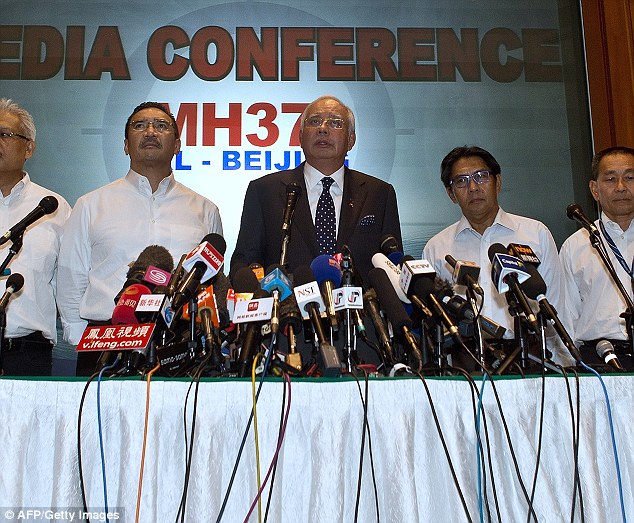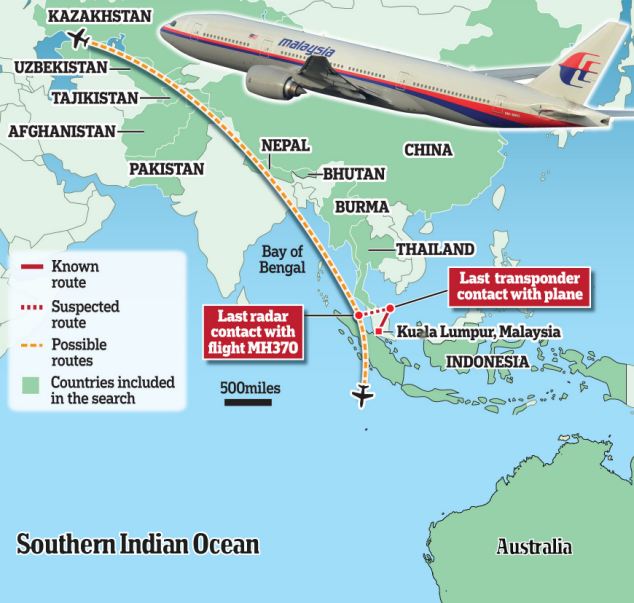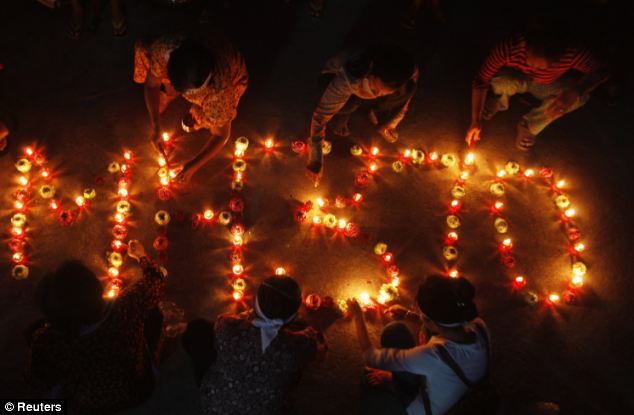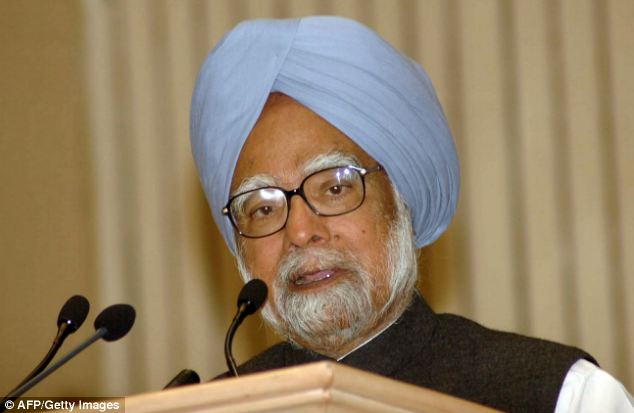
- Kazakhstan says there was no 'unsanctioned use' of its air space
- Malaysia appealed for radar data and search planes to help the hunt
- 26 countries have answered the call, including the U.S. and France
- Australian PM Tony Abbott agreed to help after talking to Malaysia's leader
- Six Australians were on board the flight carrying 239 passengers
- India rejects fear it could have been intended target of 9/11-style attack
- Indian security sources 'rubbish' idea that plane flew near an Indian city
- Searchers still don't know if the aircraft has come down on land or sea
- Total area now being examined amounts to 28million square miles
- That is equivalent to twice the size of Africa or a tenth of the planet
The move came as Malaysia's transport minister Hishammuddin Hussein revealed that two million square miles still need to be searched.
Malaysia has appealed for radar data and search planes to help in the unprecedented hunt through a vast swath of Asia stretching north-west into Kazakhstan.
It said searches have begun in both the northern and southern corridors of a vast swath of Asia where the jet may have ended up.
The Malaysian government has revealed an investigation indicates the jet was deliberately diverted and flew for several hours after leaving its scheduled flight path.
Investigators say Malaysia Airlines Flight 370 was deliberately diverted and its communications equipment switched off shortly after take-off during an overnight flight from Kuala Lumpur to Beijing on March 8.
Suspicion has fallen on anyone on board the plane with aviation experience, in particular the pilot Captain Zaharie Ahmad Shah and co-pilot.
Today, the airline said it believes the co-pilot Fariq Hamid spoke the jet's final words to ground controllers.
Malaysian police confiscated a flight simulator from the home of the pilot on Saturday and also visited the home of the co-pilot, in what Malaysia's police chief Khalid Abu Bakar said was the first visit to their homes.
The government issued a statement today contradicting that account by saying that police first visited the pilots' homes on March 9, the day after the flight.
Malaysian Defense Minister Hishammuddin Hussein also said at a news conference that finding the plane was still the main focus, and he did not rule out finding it intact.
'The fact that there was no distress signal, no ransom notes, no parties claiming responsibility, there is always hope,' Hishammuddin said.

Today it was revealed Britain and France are now among the countries providing help along with Australia, which will take responsibility for the 'southern vector'.
French investigators arriving to lend expertise from the two-year search for an Air France jet that crashed into the Atlantic Ocean in 2009.
'It's very different from the Air France case. The Malaysian situation is much more difficult,' Jean Paul Troadec, a special adviser to France's aviation accident investigation bureau, said in Kuala Lumpur.
Kazakhstan said it had not detected any 'unsanctioned use' of its air space by any planes on March 8, making it unlikely that a missing Malaysia Arlines jetliner could have been diverted along a northern route via Thailand.
The flight could hypothetically have reached the Central Asian nation's air space, but it would have been detected there, the Kazakh Civil Aviation Committee said in a detailed statement.
The Countries Answering Malaysia's Call For Help
The countries helping the hunt for missing flight MH370 are:
Malaysia, Australia, Bangladesh, Brunei, China, France, India, Indonesia, Japan, Kazakhstan, Kyrgyzstan, Laos, Myanmar, New Zealand, Pakistan, Philippines, Russia, Singapore, South Korea, Thailand, Turkmenistan, UAE, UK, U.S., Uzbekistan and Vietnam.
Assistance requested from all these countries, where applicable, is radar and satellite information, land, sea and aerial search operations and search and rescue action plans of those countries.
Malaysia Airlines planes had made nine regular flights to and from Europe over Kazakhstan's territory on March 8, it said.
Australian Prime Minister Tony Abbott told parliament that he agreed to take the lead in scouring the southern Indian Ocean for the 'ill-fated aircraft' during a conversation today with Malaysia's leader Najib Razak.
Abbott, who revealed he had no information that the flight may have come close to Australia, said he was responding to a request from Mr Razak.
'He asked that Australia take responsibility for the search on the southern vector, which the Malaysian authorities now think was one possible flight path for this ill-fated aircraft,' Abbott told parliament.
'I agreed that we would do so. I offered the Malaysian prime minister additional maritime surveillance resources which he gratefully accepted.'
Abbott said the defence chiefs of Australia and Malaysia were discussing how to implement the arrangement.
'Australia will do its duty in this matter. It will do our duty to ensure that our search and rescue responsibilities are maintained and upheld,' he said.
'And we will do our duty to the families of the 230 people on that aircraft who are still absolutely devastated by their absence and who are still profoundly, profoundly saddened by this as yet unfathomed mystery.'
Asked earlier whether Australian agencies had detected the plane close to Australia, given its western coast borders the Indian Ocean, Abbott said: 'I don't have any information to that effect.
'But all of our agencies that could possibly help in this area are scouring their data to see if there's anything that they can add to the understanding of this mystery,' he told reporters.
Australia has two Orion surveillance aircraft assisting with the search for the plane, which was en route to Beijing when it disappeared. Abbott said one of those had now been redeployed to the Indian Ocean.
Six Australians were on board the commercial flight carrying 239 passengers and crew which vanished on March 8 in a busy Southeast Asian sky, and relatives have clung to hope that their loved ones may still be alive.
'I haven't got a clue what is going on, but maybe they have been hijacked and that gives me hope,' David Lawton, whose brother Bob was aboard MH370, told the Australian Broadcasting Corporation on Monday.
'In this day and age and the technology we have you would think they would be able to find it, but no, apparently they can't.
'I don't blame anybody for it, I just want to know what their fate was,' he added.
Abbott said the incident could lead to changes in how aircraft are tracked.
'I think that there will be a lot of analysis done of this particular event which thus far remains deeply, deeply mysterious,' he said.
'And I think there will be a lot of lessons learnt, and I dare say some of those lessons will involve the tracking of aircraft.'
Australia already had two AP-3C Orion aircraft involved in the search, one of them looking north and west of the remote Cocos Islands.
Malaysian authorities have said the satellite signal or 'ping' received from the jet carrying 239 people more than seven hours after it took off shows that it also may have entered a northern corridor stretching over land from south-east Asia north-west into central Asia.
Britain's Role In The HuntMeanwhile, India has rejected suggestions that it could have been the intended target of a 9/11-style attack by the missing jet.
The UK was including in a list of countries helping out in the search today.
Here is what the Foreign and Commonwealth Office said: 'A senior team from its Air Accidents Investigation Branch has been deployed to Kuala Lumpur.
'The AAIB offered its assistance to the Malaysian authorities as the investigation body for the state of manufacture of the engines. This is the normal procedure for any incident involving an aircraft with UK manufactured engines.
'The means there will be expertise on the ground in the region for when the aircraft is discovered and the Malaysian authorities move rapidly into the investigation phase.
'The AAIB team's first task will be to bring themselves up to speed on the facts as known at this stage, and to consult with the Malaysian investigation experts.'
As Prime Minister Manmohan Singh promised maximum assistance in the massive hunt for Flight 370, India's foreign minister said it was vital that the mystery over its fate was cleared up.
But asked by the CNN-IBN network about suggestions that the plane was hijacked with the aim of flying it into an Indian city, Foreign Minister Salman Khurshid replied: 'I don't think we have gone that far.'
The speculation was fuelled by former U.S. deputy secretary of state Strobe Talbott who tweeted that the 'direction, fuel load and range now lead some to suspect hijackers planned a 9/11-type attack on an Indian city'.
His comments over the weekend have been widely picked up by the Indian media and Khurshid said people needed answers to allay their fears.
'We hope to come to some conclusion that is both credible and reassuring,' he said.
The Times of India said security sources had 'rubbished' the idea that the plane could have got anywhere close to an urban centre and insisted it would have been detected by a naval base on the Andaman islands, more than 1,000 kilometres (600 miles) off the Indian mainland.
'There is no way our military radars would have missed the airliner as it flew over Andaman Sea, as there is high traffic around that time,' one military intelligence source told the paper.
The U.S.-led NATO mission in Afghanistan meanwhile said it was not looking for the missing plane there, and Islamabad's Civil Aviation Authority said the flight never appeared on Pakistani radar.
Indian ships and planes scoured the seas off the sprawling Andamans archipelago last week but they suspended their search on Sunday as they awaited fresh instructions from Malaysian authorities.
'Operations are suspended as of now, everything is grounded,' Indian Navy spokesman D.K. Sharma said.
'Malaysian authorities will now decide and tell us where to go. They have asked us to be on standby for now. We are awaiting further instructions. Once we have them, we will move.'
Prime Minister Singh's office said that his Malaysian counterpart Najib Razak, in a phone call late Sunday, had requested 'technical assistance from Indian authorities in corroborating the possible paths that the missing Malaysian airliner might have taken'.
Singh 'assured all possible assistance from concerned Indian authorities', the office said in a statement.
A huge area spanning the rainforests of South East Asia and the landscapes of former Soviet Union republics is now part of the investigation into the fate of Flight MH370, which set out nine days ago on a routine flight from Kuala Lumpur to Beijing.
Excruciatingly for the families of the 239 people on board, searchers from 25 nations still have no idea whether the aircraft has come down on land or sea.


The plane's last signal, which was picked up by a satellite orbiting more than 22,000 miles above the Indian Ocean, placed it along one of two arcs - referred to as air corridors.
One runs from the southern border of Kazakhstan in Central Asia to northern Thailand.
The other runs from near Jakarta, Indonesia, to the Indian Ocean, some 1,000 miles off Australia's west coast.
The authorities believe the last signals picked up by satellite could possibly have been transmitted when the plane was on land - and yesterday, after a fruitless hunt of oceans to the east and west of Malaysia, authorities in Kuala Lumpur announced that searches have begun across 11 different countries.
The 'straight line' distance from the most southerly point of the search, in the southern Indian Ocean, to the most northerly area in Central Asia is an enormous 6,000 miles.
And in a remarkable development, Indian officials have suggested that the jet could have 'slipped through' radar gaps on its way over the ocean.
Rear Admiral Sudhir Pillai explained: 'We have many radar systems operating in this area. Nothing was picked up, but it's possible that the military radars were switched off as we operate on an "as required" basis.'
And senior Indian Air Force and Navy officers have admitted there are a 'few gaps' in the country's civil and military radar networks, a measure which keeps costs down - although they stressed that it would be 'virtually impossible' for it to have crossed into Indian air space and remain undetected.
The same applies to Pakistan, which has led some to believe that the jet did not get as far as the subcontinent.
If it did not plunge into the Indian Ocean, the plane could have landed on an airstrip long enough to accommodate a Boeing 777 - a required distance of 5,000ft, or almost a mile.
US radio station WNYC has put together a list of 634 runways that meet this criteria in the flying range from Kuala Lumpur of the missing jet - with some located in far-flung destinations such as Mongolia and Yap in Micronesia.
Malaysian transport minister Hishammuddin Hussein said yesterday that the search had become 'even more difficult'.
He added: 'This is a significant recalibration. What we're doing here may change aviation history.'
Hishammuddin Hussain added that the number of countries involved in the operation had increased from 14 to 25.





Money to burn in their pursuit of lies. Now we know the truth we have one huge expose as usual. The Games they Play - the perpetual merrygoround.
While they try to distract the masses let us guess their next move - bound to be one, will it be just as risky?